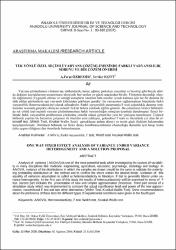| dc.contributor.author | Özdemir, A.Fırat | |
| dc.contributor.author | Kurt, Serdar | |
| dc.date.accessioned | 2015-02-20T13:53:23Z | |
| dc.date.available | 2015-02-20T13:53:23Z | |
| dc.date.issued | 2007 | |
| dc.identifier.issn | 13023160 | |
| dc.identifier.uri | https://hdl.handle.net/11421/1504 | |
| dc.description.abstract | Varyans çözümlemesi yöntemi tıp, mühendislik, tarım, eğitim, psikoloji, sosyoloji ve biyoloji gibi birçok alanda değişim kaynaklarının araştırılması sürecinde başvurulan en güçlü araçlardan biridir. Yöntemin dayandığı olasılık dağılımının (F) geçerli olması ve verdiği sonuçların istenilen hata sınırları içinde kalması için her bir deneme ile elde edilen gözlemlerin eşit varyanslı kitlelerden çekilmesi gerekir. Bu varsayımın sağlanmaması literatürde farklı varyanslılık (heteroscedasticity) olarak adlandırılır. Farklı varyanslılık durumunda F testi çoğunlukla deneme ortalamaları arasında gerçekte olmayan anlamlı farklar bulma yönünde eğilim gösterir. Bu çalışmanın birinci bölümünde tek yönlü özel seçimli varyans çözümlemesinde farklı varyanslılığın sonuçları üzerinde durulmuştur. İkinci bölümde farklı varyanslılık probleminin çözümüne yönelik olarak geliştirilen yeni bir yaklaşım tanıtılmıştır. Üçüncü bölümde yapılan bir benzetim çalışması ile önerilen yeni yaklaşım, geleneksel F testi ve literatürde yer alan iki alternatif test, (Welch Testi, Kruskal-Wallis Testi) gerçekleşen anlam düzeyi ve testin gücü ölçütleri bakımından karşılaştırılmıştır. Dördüncü bölümde ise farklı deney kombinasyonlarının oluşturduğu durumlar için hangi testin daha uygun olduğuna dair önerilerde bulunulmuştur. | en_US |
| dc.description.abstract | Analysis of variance ( ANOVA) is one of the most powerful tools while investigating the sources of variability in many disciplines like medicine, engineering, agriculture, education, psychology, sociology and biology. In ANOVA, variance of the distributions in which the samples are drawn should be the same to validate the underlying probability distribution of the method and to confine the errors within the desired limits. Violation of this equality of variances assumption is called as heteroscedasticity in literature. F test is generally liberal under variance heterogeneity. In the first part of this study the results of heteroscedasticity will be examined in terms of F test. Second part includes the presentation of new and simpler approximation procedure. Third part consist of a simulation study which was implemented to compare the actual significance level and power of the new approximation, conventional F test and two other alternatives (Welch Test, Kruskal-Wallis Test). Some recommendations about the preference of these tests for different types of experimental conditions were given in the fourth part. | en_US |
| dc.language.iso | tur | en_US |
| dc.publisher | Anadolu Üniversitesi | en_US |
| dc.rights | info:eu-repo/semantics/openAccess | en_US |
| dc.subject | ANOVA | en_US |
| dc.subject | Farklı Varyanslılık | en_US |
| dc.subject | F Testi | en_US |
| dc.subject | Welch Testi | en_US |
| dc.subject | Kruskal-Wallis Testi | en_US |
| dc.subject | ANOVA | en_US |
| dc.subject | Heteroscedasticity | en_US |
| dc.subject | F test, Welch Test | en_US |
| dc.subject | F test | en_US |
| dc.subject | Welch Test | en_US |
| dc.subject | Kruskal-Wallis Test | en_US |
| dc.title | Tek Yönlü Özel Seçimli Varyans Çözümlemesinde Farklı Varyanslılık Sorunu ve Bir Çözüm Önerisi | en_US |
| dc.title.alternative | One Way Fixed Effect Analysis of Variance Under Variance Heterogeneity and a Solution Proposal | en_US |
| dc.type | article | en_US |
| dc.relation.journal | Anadolu Üniversitesi Sosyal Bilimler Dergisi | en_US |
| dc.relation.publicationcategory | Makale - Uluslararası Hakemli Dergi - Kategorisiz | en_US |


















